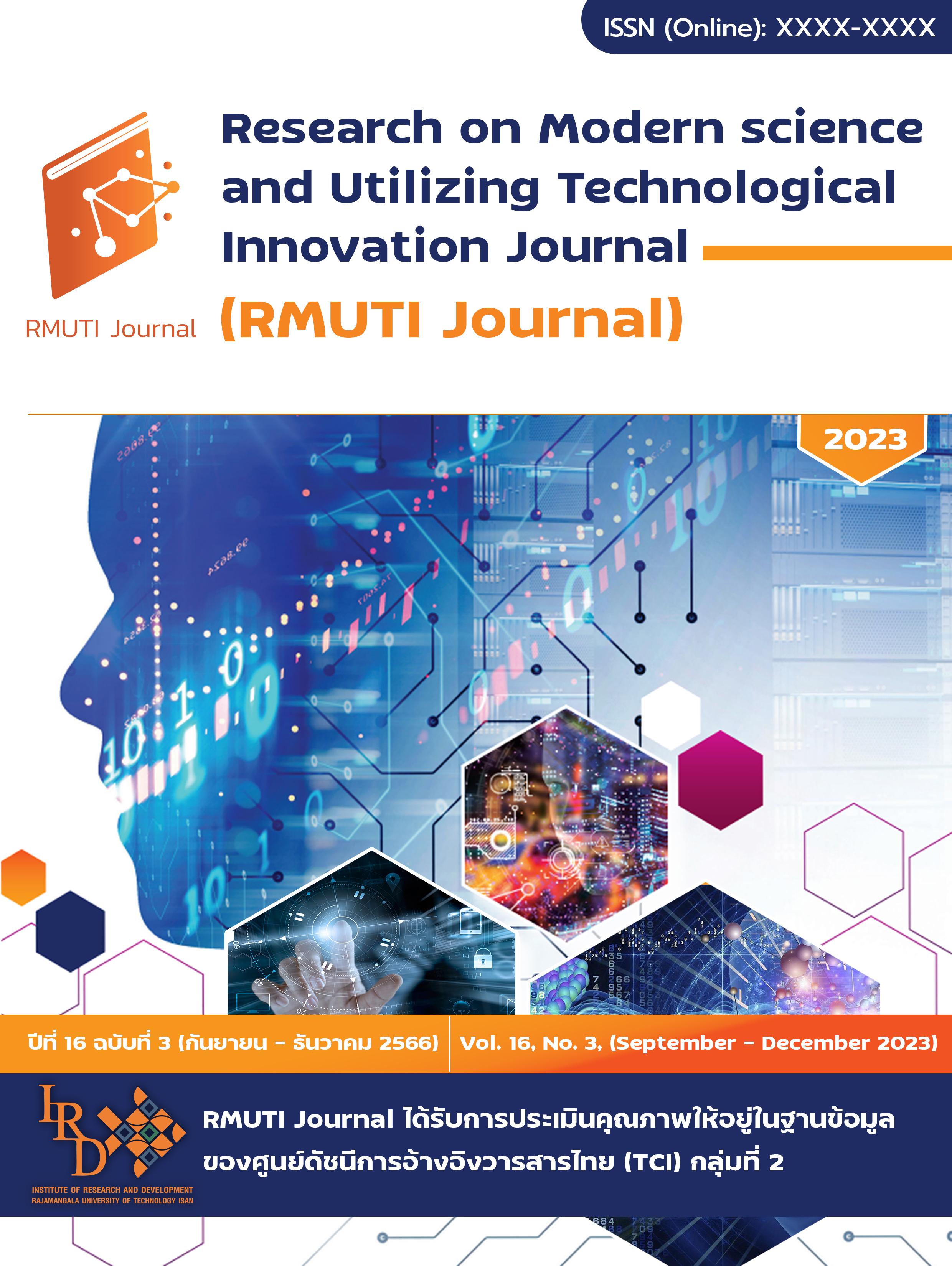The Study of the Reinforced Masonry Walls with Bamboo under the Pendulum Test
Main Article Content
Abstract
The objective of this research was to study the reinforced masonry walls with bamboo under the pendulum test. A total of 6 samples of masonry walls were tested, with an average size of 600 x 600 mm, consisting of 1) non-plastered Mon brick wall (CT1), 2) plastered Mon brick wall (CT2), 3) reinforced masonry wall with bamboo at a distance of 50 mm (W1), 4) reinforced masonry wall with bamboo at a distance of 100 mm (W2), 5) reinforced masonry wall with bamboo at a distance of 150 mm (W3), and reinforced masonry wall with bamboo at a distance of 200 mm (W4). Assessments were performed using the pendulum test with application angles ranging from 5 to 90 degrees. The results found that samples CT1, CT2, W1, W2, W3 and W4 had impact load values of 9.04, 21.33, 39.2, 34.28, 26.92, and 25.01 N.m, respectively. For the control sample CT2, it was shown that plastering the masonry wall resulted in a 2.36 times higher impact load when compared with sample CT1. In addition, when comparing the masonry wall samples reinforced with bamboo at a distance of 50 to 200 mm with the CT2 sample, it was found that walls W1, W2, W3, and W4 had 1.83, 1.61, 1.26, and 1.17 times higher impact load, respectively. Thus, it can be concluded that reinforcement using the reinforced masonry walls with bamboo significantly increased the impact load.
Article Details

This work is licensed under a Creative Commons Attribution-NonCommercial-NoDerivatives 4.0 International License.
References
Meteorological Department. (2017). Earthquake Report in Thailand and Adjacent Areas in June 2017 Seismological Bureau. Access (23 July 2023). Available (https://earthquake.tmd.go.th/report/file/seismo-report-1504512433.pdf) (in Thai)
Albert, M. L., Elwi, A. E., and Cheng, J. J. R. (2001). Strengthening of Unreinforced Masonry Walls using FRPs. Journal of Composite for Construction. Vol. 5, No. 2, pp.76-84. DOI: 10.1061/(ASCE) 1090-0268(2001)5:2(76)
Ghobarah, A. and El Mandooh Galal, K. (2004). Out-of-Plane Strengthening of Unreinforced Masonry Walls with Openings. Journal of Composites for Construction. Vol. 8, No. 4, pp. 298-305. DOI: 10.1061/(ASCE)1090-0268(2004)8:4(298)
Gilstrap, J. M. and Dolan, C. W. (1998), Out-of-plane Bending of FRP-ReinforcedMasonry Walls. Composites Science and Technology. Vol. 58, No. 8, pp. 1277-1284. DOI:10.1016/S0266-3538(98)00007-4
Hamilton, H. R. and Dolan, C. W. (2001). Flexural Capacity of Glass FRP Strengthened Concrete Masonry Walls. Journal of Composites for Construction. Vol. 5, No. 3, pp.170-178. DOI: 10.1061/(ASCE)1090-0268(2001)5:3(170)
Hamoush, S. A., McGinley, M. W., Mlakar, P., Scott, D., and Murray, K. (2001). Out-of-Plane Strengthening of Masonry Walls with Reinforced Composites. Journal of Composites for Construction. Vol. 5, No. 3, pp. 139-145. DOI: 10.1061/(ASCE)1090-0268(2001)5:3(139)
Kiss, R. M., Kollar, L. P., Jai, J., and Krawinkler, H. (2002). Masonry Strengthened with FRP Subjected to Combined Bending and Compression, Part II: Test Results and Model Predictions. Journal of Composite Materials. Vol. 36, No. 9, pp. 1049-1063. DOI: 10.1177/0021998302036009475
Saileysh Sivaraja, S., Thandavamoorthyb, T. S., Vijayakumarc, S., Mosesaranganathana, S., Rathnasheelad, P. T., and Dasarathye, A. K. (2013). GFRP Strengthening and Applications of Unreinforced Masonry Wall (UMW). Procedia Engineering. Vol. 54, pp. 428-439. DOI: 10.1016/j.proeng.2013.03.038
Kahn, L. F. (1984). Shotcrete Strengthening of Brick Masonry Walls. Concrete International: Design and Construction. Vol. 6, No. 7, pp. 34-39
Schmidt, M. E. and Cheng, L. (2009). Impact Response of Externally Strengthened Unreinforced Masonry Walls using CFRP. Journal of composites for Construction. Vol. 13, No. 4, pp. 252-261. DOI: 10.1061/(ASCE)CC.1943-5614.0000011
Standard of Precast Concrete Wall Panels. Thai Industrial Standard Institute. TISI 2226/2005.
James, E. (2000). The Simple Pendulum. Access (15 May 2023). Available (http://www.phys.utk.edu/labs/simplependulum.pdf)
Standard Portland Cement. Thai Industrial Standard Institute. TISI 15/2019.
Standard Test Method for Compressive Strength of Dimension Stone. American Society for Testing and Materials. ASTM C170-90.
Standard Test Method for Compressive Strength of Masonry Prisms. American Society for Testing and Materials. ASTM C1314-07.
Standard Test Method for Compressive Strength of Hydraulic Cement Mortars. American Society for Testing and Materials. ASTM C349-97.
Standard Test Method for Breaking Strength and Elongation of Textile Fabrics (Grab Test). American Society for Testing and Materials. ASTM D5034-21.
Standard of Structural Clay Nonloadbearing Screen Tiles. Thai Industrial Standard Institute. TISI 153/1997.
Leeanansaksiri, A. (2022). A Study of Compressive Strength on Masonry Infilled Walls under Pendulum Test. In The 9th National and the 7th International Conference on Research and Innovation Development for the Next Normal Society: Transition from the New Normal. pp. 503-514. (in Thai)
Lea, F. M. (2019). The Chemistry of Cement and Concrete. (5th ed). Butterworth-Heinemann
Ounjaijom, T., Maneeinta, N., and Punyacum, W. (2017). Mechanical Properties of Five Species Dried Bamboo. Srinakharinwirot University Engineering Journal. Vol. 12, No. 2, pp. 8-14 (in Thai)
Leeanansaksiri, A., Panyakapo, P., and Ruangrassamee, A.(2018). Seismic Capacity of Masonry Infilled RC Frame Strengthening with Expanded Metal Ferrocement. Engineering Structures. Vol. 159, pp. 110-127. DOI: 10.1016/j.engstruct.2017.12.034

